Bacteria and its application in absorbing VOCs
A technology of bacteria and fungi, applied in the field of VOCs treatment, can solve the problem of low waste gas treatment efficiency, achieve high degradation efficiency and good treatment effect
- Summary
- Abstract
- Description
- Claims
- Application Information
AI Technical Summary
Problems solved by technology
Method used
Image
Examples
preparation example Construction
[0030] The preparation method of described synthetic adsorbent comprises the following steps:
[0031] (a) analyzing the element content in the blast furnace slag by X-ray fluorescence spectrometry, and calculating the ratio of Mg / (Mn+Si) to 0.05-0.09 and the ratio of Mn / (Mn+Si) to 0.187-0.213 through the element content;
[0032] (b) Adjust blast furnace slag Mg / (Mn+Si) ratio and Mn / (Mn+Si) ratio, add MgO and SiO to 1g blast furnace slag 2 Adjust the Mg / (Mn+Si) ratio and the Mn / (Mn+Si) ratio to 0.83-0.85 and 0.142-0.148 respectively to prepare a mixture A;
[0033] (c) Add 32-35mL deionized water to the mixture A prepared in step b, and stir for 12-15min at a microwave power of 100-150W, a temperature of 30-35°C, and a rotation speed of 200-300r / min to obtain mixture B;
[0034] (d) Put the mixture B prepared in step c in a reaction kettle, react at 400-500°C for 4-6h to obtain a reaction product, wash the reaction product with deionized water, and dry it at 75-82°C until i...
Embodiment 1
[0043] Such as figure 1 Shown: a reaction system for absorbing VOCS, including an ultraviolet light treatment chamber 1, a circulating liquid device 2, and an absorption reaction tower 3. The ultraviolet light treatment chamber 1 is connected to the absorption reaction tower 3 through a pipeline A, and the circulation The liquid device 2 is connected to the top of the absorption reaction tower 3 through a pipe B, and the circulating liquid device 2 is connected to the bottom of the absorption reaction tower 3 through a pipe C.
[0044] The ultraviolet light treatment chamber 1 includes an air inlet 11 .
[0045] The circulating fluid device 2 includes a temperature sensor A 21 and a pH electrode 22 , the temperature sensor A 21 is arranged on the top of the circulating fluid device 2 , and the pH electrode 22 is arranged on the bottom of the circulating fluid device 2 .
[0046] The absorption reaction tower 3 includes a grid-type biofilm filler 31, a temperature sensor B 32,...
Embodiment 2
[0061] Such as figure 1 Shown: a reaction system for absorbing VOCS, including an ultraviolet light treatment chamber 1, a circulating liquid device 2, and an absorption reaction tower 3. The ultraviolet light treatment chamber 1 is connected to the absorption reaction tower 3 through a pipeline A, and the circulation The liquid device 2 is connected to the top of the absorption reaction tower 3 through a pipe B, and the circulating liquid device 2 is connected to the bottom of the absorption reaction tower 3 through a pipe C.
[0062] The ultraviolet light treatment chamber 1 includes an air inlet 11 .
[0063] The circulating fluid device 2 includes a temperature sensor A 21 and a pH electrode 22 , the temperature sensor A 21 is arranged on the top of the circulating fluid device 2 , and the pH electrode 22 is arranged on the bottom of the circulating fluid device 2 .
[0064] The absorption reaction tower 3 includes a grid-type biofilm filler 31, a temperature sensor B 32,...
PUM
| Property | Measurement | Unit |
|---|---|---|
| particle diameter | aaaaa | aaaaa |
Abstract
Description
Claims
Application Information
 Login to View More
Login to View More - R&D
- Intellectual Property
- Life Sciences
- Materials
- Tech Scout
- Unparalleled Data Quality
- Higher Quality Content
- 60% Fewer Hallucinations
Browse by: Latest US Patents, China's latest patents, Technical Efficacy Thesaurus, Application Domain, Technology Topic, Popular Technical Reports.
© 2025 PatSnap. All rights reserved.Legal|Privacy policy|Modern Slavery Act Transparency Statement|Sitemap|About US| Contact US: help@patsnap.com



